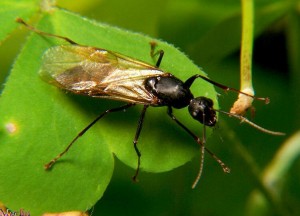
Winged Carpenter Ants
Winged Carpenter Ants (Camponotus spp.)
The presence of winged carpenter inside the home during the summer, does not by itself, mean you have a carpenter ant nest in your home. Carpenter ants are one of the largest and most common species of ants in Michigan. Unlike termites, they only nest in wood and do not eat it. Outdoors they nest in hollow trees, old stumps, and other wet, punky wood situations. Winged ants are the reproductive forms. They drop their wings soon after mating and begin to search for a suitable nesting site. They commonly enter structures but only rarely do they succeed in finding a nest site and most winged forms die before establishing a nest. If you have not seen carpenter ants in the home during the winter months, then you probably don’t have much to worry about. When they do nest indoors, they prefer wood that is wet and punky (by leaky pipes and drains, under leaky roof shingles), but they have been found in dry areas such as hollow doors and false beams. The presence of ants in the house during late fall, winter and early spring is usually a sign of a nest indoors.
When they do nest indoors, they prefer an enclosed space with wood that remains wet or damp, more or less, or a permanent basis. Carpenter ants are attracted to excessive moisture conditions around windows, doors, showers, bathtubs, dishwashers, leaky pipes and drains, and under leaky roof shingles. They have also been found in dry areas such as hollow-core doors and false beams, and blue board foam insulation.
The best method of control is to locate the nest and treat it directly with Dursban (Ortho Home Pest Insect Control) or other ant killer registered for indoor use. Make any repairs, if necessary, to keep the area dry. Finding the nest can be difficult since carpenter ant are most active at night. Begin looking in the rooms where the greatest numbers are found and observe where they go or come from. Look for accumulations of coarse sawdust and dead ants. Try mixing 2 oz. (1/4 cup) of grape or apple mint jelly with 1 teaspoon of ground up dried pet food and use this as a bait to get them feeding and carrying food back to the nest. Put a teaspoon of the bait on a jar lid or piece of foil and place out of the reach of children and pets, near where you see the ants. If the nest cannot be found, poison the bait by adding 1/2 teaspoon of boric acid powder to the mixture. Bait the ants for 4 to 6 weeks, replacing the bait as it dries out.
Be sure to read and follow all the instructions and safety precautions found on the pesticide label before using any pesticide.




 Print
Print Email
Email




